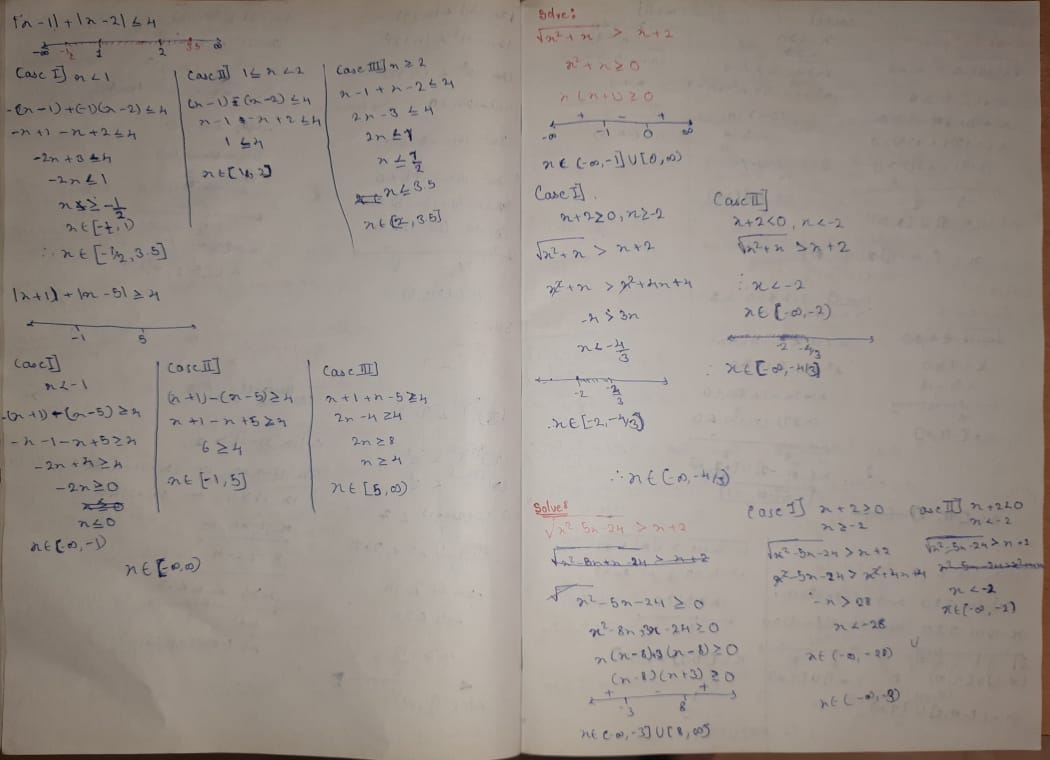Solve the given inequalities and find the values of n.

Understand the Problem
The question appears to involve solving inequalities and finding the values of 'n' that satisfy certain conditions. The approach involves breaking down the problem into cases based on the expressions and determining the ranges for each case.
Answer
The values of \( n \) that satisfy the inequalities are \( n \in (-\infty, \frac{7}{2}] \).
Answer for screen readers
The solution to the inequality is:
$$ n \in (-\infty, \frac{7}{2}] $$
Steps to Solve
-
Identifying Cases The problem appears to involve three cases based on different conditions for $n$. Each case must be handled separately to determine the valid intervals.
-
Case I: $n \leq 1$
- Set up the inequalities based on the absolute value condition. The inequalities derived are: $$ (n - 1) + (n - 2) \leq 4 $$
- Solve the inequality: $$ n - 1 + n - 2 \leq 4 $$ Combine like terms: $$ 2n - 3 \leq 4 $$ Adding 3 to both sides: $$ 2n \leq 7 $$ Dividing by 2: $$ n \leq \frac{7}{2} $$
-
Case II: $1 < n < 2$
- Again, set up the inequalities: $$ (1 - n) + (n - 2) \leq 4 $$
- Solve: $$ 1 - n + n - 2 \leq 4 $$ Simplifying gives: $$ -1 \leq 4 $$ This inequality always holds, thus: $$ n \in (1, 2) $$
-
Case III: $n \geq 2$
- Setup: $$ (n - 1) + (n - 2) \leq 4 $$
- Solve: $$ n - 1 + n - 2 \leq 4 $$ Which simplifies to: $$ 2n - 3 \leq 4 $$ Further simplifies to: $$ n \leq \frac{7}{2} $$ So for this case: $$ n \in [2, \frac{7}{2}] $$
-
Combine Results
- From all cases, summarize the intervals obtained:
- Case I: $(-\infty, 1]$
- Case II: $(1, 2)$
- Case III: $[2, \frac{7}{2}]$
- Combined results yield: $$ n \in (-\infty, \frac{7}{2}] $$
The solution to the inequality is:
$$ n \in (-\infty, \frac{7}{2}] $$
More Information
This result indicates that any value of ( n ) that is less than or equal to ( \frac{7}{2} ) satisfies the original inequalities. Note that the method involved analyzing the absolute values and setting up separate intervals to solve for ( n ).
Tips
- Neglecting absolute value conditions: Ensure each case correctly interprets the impact of the absolute value, as it can result in missed intervals.
- Combining ranges improperly: When merging the intervals, be careful to include all parts of the solution from each case.
AI-generated content may contain errors. Please verify critical information